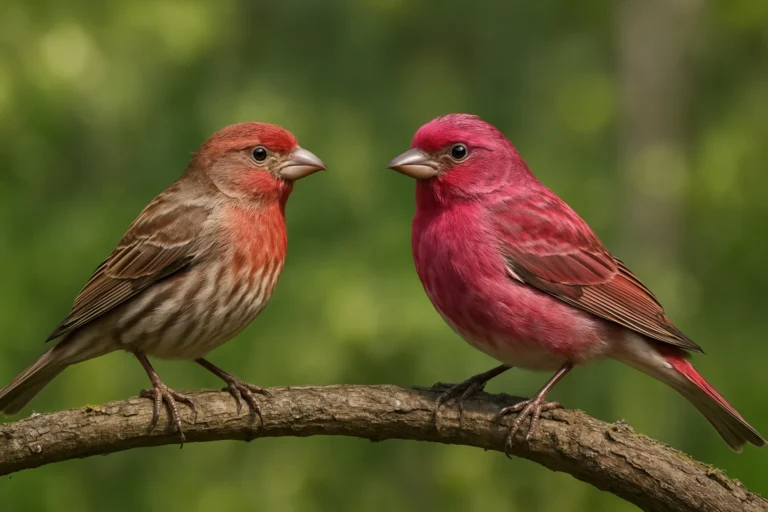Ever spotted a small reddish bird and wondered which finch it was? You’re not alone, then. In fact, many birdwatchers get puzzled by the purple finch vs the house finch. Telling one apart from another is challenging even for the most seasoned birdwatchers. These two similar-looking birds share many characteristics but have distinctive features worth noting. There are subtle differences in coloration, head shape, and behavior that often escape casual observation.
And you know what further complicates identification for beginners? We’re talking about seasonal plumage variations and regional distribution patterns. However, you must learn about these distinctions to transform your birdwatching experience from confusion to clarity. So, keep scrolling down if you want to spot the dissimilarities between the purple finch (Haemorhous purpureus) and the house finch (Haemorhous mexicanus) like a pro.
This blog will illuminate the key differences between these two remarkable birds.
Why It’s Easy to Confuse These Two Finches
These finches share a remarkably similar size. Both typically measure between five and six inches long. Both species frequent backyard feeders throughout much of North America, especially during winter months. Their seasonal ranges overlap across the Eastern US, creating countless identification challenges.
Female finches of both species look even more alike than their colorful male counterparts. Both species demonstrate similar feeding behaviors when visiting your backyard bird stations. Their body shapes appear nearly identical when perched on branches or at feeders. But it doesn’t mean that telling them apart is impossible. You just need to know what subtle clues to look for.
Key Visual Differences
Do you think identification is difficult? Worry not. Comparing the genders of both types of finches makes things easier. So, let’s begin with the males:
Male Purple Finch vs House Finch
The male purple finch displays a rich raspberry-red coloration that appears washed over its entire body. House finch males show a brighter orange-red that concentrates mainly on the head and chest. Purple vs house finch males differ in their streaking patterns across the belly and flanks.
Purple finches have stronger color extending to their backs, creating a more uniformly colored appearance. House finches show clearer boundaries between their colorful and brown-gray areas throughout their bodies. The purple finch has a thicker, more conical bill than its house finch counterpart.
Female Purple Finch vs House Finch
Female purple finches display a bold facial pattern with distinct light eyebrow streaks. House finch females have plainer faces without the striking contrast seen in purple finches. The female purple finch shows a whitish eyebrow stripe that stands out against its face.
Female purple finches appear more heavily streaked across their underparts than house finch females. House finch females have a grayish-brown appearance, while purple finch females look slightly more olive-toned. The difference in bill size remains consistent in females, with purple finches having stouter bills.
Habitat and Range
Purple finches prefer coniferous or mixed forests across Canada and the northern United States. House finches adapt wonderfully to suburban areas, city parks, and farmlands throughout North America. Purple finches migrate southward during winter, while many house finch populations remain year-round residents.
The house finch originally inhabited only western North America before spreading eastward in recent decades. Purple finches visit feeders less regularly and often prefer wooded areas away from human development. House finches have successfully colonized nearly every corner of the continental United States.
Eastern bird watchers may spot both species during winter at their backyard feeders. Western birders typically encounter house finches more frequently than their purple cousins. Climate change continues affecting both species’ ranges, potentially creating new overlap zones.
Song and Behavior
Song and Behavior Purple finches sing with a richer, more musical warbling song that rises and falls. House finches produce a cheerful but scratchier song with shorter phrases and more variable patterns. Purple finches often sing from high perches, projecting their melody across their woodland territories.
House finches tend to gather in larger flocks than the more solitary purple finches. Purple finches crack seeds with their stronger bills, while house finches manipulate seeds differently. Both species enjoy sunflower seeds, but purple finches more readily consume larger seed types.
Purple finches typically nest in coniferous trees, constructing their homes away from human dwellings. On the other hand, house finches build nests in various human-made structures, including hanging planters and light fixtures. House finch nestlings develop slightly faster than purple finch babies.
Easy Tips to Tell Them Apart
If you’re a new birder, it’s really easy to feel confused between two nearly identical avians. There’s nothing to worry about, though. We’ve designed a quick ID checklist to give beginner birdwatchers some quick wins while watching finches in the wild or at feeders. Think of these differences like clues in a natural puzzle. These small details can make big differences for your birdwatching journey.
Try these easy birdwatching tips to spot who’s who:
Purple Finches:
- Males look like they’ve been dipped in raspberry juice from head to tail.
- Females have a white eyebrow and a more contrasting face pattern.
- Show an overall wash of color, even on the back and flanks.
- Appear smoother and more rounded than house finch heads.
- Have bold, clean faces with a noticeable eye stripe.
- Move calmly, often feeding alone or in pairs.
- Tail is short and shows a deep notch at the tip.
- Less common at feeders, usually seasonal visitors.
House Finch
- Males show red-orange coloring mainly on the head, throat, and upper chest.
- Females have plain brown coloring with blurry streaks and no strong facial markings.
- Back and sides appear duller with noticeable color contrast from the head.
- Head shape is flatter and less rounded than purple finch.
- Streaks on the belly and flanks are dark and easy to spot.
- Facial features are soft, with no bold lines or eye stripes.
- Tail is longer with a straighter, more squared-off tip.
- Very common in towns and cities year-round.
Remember, no single trait is enough to differentiate between purple and house finches. You need to use these visual cues together for better ID outcomes. And lastly, the more you practice, the faster your eye will catch these differences.
House Finch vs Purple Finch: Final Thoughts for New Birders
In short, telling a house finch from a purple finch apart isn’t a hard nut to crack. Regular practice and observation can make distinguishing between the two birds easier. There’s no doubt that both species bring wonderful color and song to our yards and natural spaces. The key differences we’ve explored will help you confidently identify these beautiful birds. However, always keep in mind that lighting conditions can dramatically affect how red these finches appear. So, take your time when observing these birds rather than making quick identification decisions.
Loved reading this blog? Keep visiting our blog for more valuable birdwatching tips.


